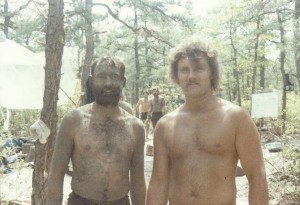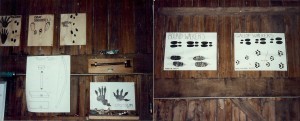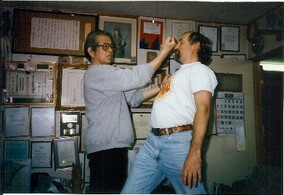
Survival Imperatives
10.12.18

At Bufestivus 2014, I taught a segment on wilderness survival. We’ve gotten a bunch of emails asking for notes on that lesson, so here they are, complete with a few pics from my training with Tom Brown and a fire-starting video!

Phil Legare & Tom Brown
\Four survival imperatives:
- Shelter
- Fire
- Water
- Food
[Two more I would add to the list, but we will discuss them at the end.]
Generally in this order, but it really does depend on your circumstances and outside conditions. If you are severely dehydrated then water may be your first imperative. If it’s pouring down rain, then your immediate need is to get to a dry area and to get dry. If its also extremely cold out, you not only need to get out of the elements but stay warm too, so a fire may be your immediate need. Generally, food can be last since it takes much longer to starve to death from lack of food than dehydration, heat stroke, hypothermia, etc. Remember how long Gandhi fasted?
The best thing to do is put most of your energy into taking care of your most immediate need, but also notice if there is a good water source nearby, collect dry wood for a fire, scan the environment for edible plants and signs of animals, etc. In other words, to survive in the wild you have to multitask.

Debris Shelter
Shelter: Pack a poncho and a survival blanket. These are great for keeping you dry and giving you a small amount of protection from the cold. The survival blanket can also be used to signal for help (reflective). Pack a bivy sack. These are very compact sleeping bags that will also help.
-If you still have a vehicle, this can be a great shelter from the elements. If the engine still runs beware of CO2 poisoning if the tailpipe is clogged up.
-A natural cave can be shelter. Beware of spiders, bats and other animals that you may have to share your cave with.
-Hanging your poncho over some tree limbs can be a make shift lean too. If its not too cold out this may be all you need.
-Build a debris shelter. This looks like a mouse hooch. Find a large broken tree limb and place the base end on top of a pile of rocks or on top of a tall stump. Lean branches on both sides of the slanted limb creating a tent. Trim or break the branches on the inside so you have room to move around. Pack as much dried leaves and boughs as you can in the spaces around the branches. Continue to add debris of your shelter. The thicker the better. If you need to use this shelter for a long period of time you can add mud to the outside to add to the insulation. Have your opening near the tree trunk or pile of rocks. Pad the floor of your shelter with soft leaves, straw, grass, etc. You should have enough room to lay down inside your debris hut and roll over, but not much more than that. Add room for your sleeping bag and you pack so they will stay dry inside. Build your fire ring close to the opening of your debris hut (but not too close) so you will benefit from the heat.
Last thoughts on shelter-Whatever shelter you build, it should be on higher ground, not susceptible to flooding, not too close to a water source, due to dampness from the vapor barrier and bugs and pests in the warmer months. 50 yards or more away from water is generally recommended. Also your major food source is going to be 4 leggeds that may frequent this water source so you don’t want to scare them off by building a fire and setting up camp right there.
Fire: Pack a couple of Bic lighters in your bag !! It may be considered cheating but you are all Ninjas!! Don’t do a bow drill fire unless it truly is a last resort. Pack water proof matches, flint and steel, metal match, etc. Crayons make great candles. Parafin wax and cotton balls make good tinder. Laura has taught you about making fire. Dry fluffy debris makes good tinder. When making a fire, gather about 5 times the amount of tinder you think you will need, then a nice pile of small sticks and twigs to go on top of the tinder once its going, then medium size sticks and then larger ones. Once you have some good coals built up you can pile on some bigger pieces. Safest/easiest fire to keep lit is a teepee fire. Pack a book on survial for dummies or worst case scenarios and study up for making a friction fire or bow drill fire as a last resort.
Last thoughts on fire- Keep your tinder dry! You made a fire. Congrats. Then it rains and for 3 days you can have a fire again because all your wood is wet. Pack some wood and tinder inside your debris hut to keep it dry in case of rain. Fire can be used to signal, to cook meat, to smoke hides to water proof and soften them, to hard arrow and spear tips and to keep warm. Fire good!
Water: Pack iodine tabs, filtration straw, osmosis filter, camelback with an osmosis filter, etc. Worst case you can filter water through your bandana or tee shirt. Use fast running clear water if at all possible to avoid dysentery. Boil water if you are able. Build a solar still if you have no apparent water source. Collect rain water. Pack a 5lb coffee can or a large metal cup filled with socks and survival gear to use to boil water and/or collect water. Needs to be able to go on a fire so no fancy paint or logos. Pack a 2’square piece of clear plastic to use in making a solar still.
Last thoughts on water- You need to stay hydrated in the wild. Dirty water is better than no water at all, but don’t be stupid. Purify it through filtration and boiling if possible. Some plants are a good source of water also, such as cactus and palmetto. Know your area.
Food: Pack survival food. MRE’s are great. They have about 5,000 calories in each pack. They are meant to help you survive and give you a lot of quick energy, but you wont do so well if you eat them every day. Pack Lara bars, protein bars, trail mix, etc for lightweight food for quick energy.
-Edible (and medicinal) plants. Carol is going to discuss these in a bit and take you on a walk around the property pointing out various plants and their uses. Generally speaking if you don’t know if a plant is good or bad for you stay away from it. Bad plants tend to look like they might be bad. To test, rub some of the leaf on the outside of your hand and wait a bit to see if there is a reaction. If no reaction, rub some on the inside of your wrist. If no reaction, smell the crushed bit of plant. If no reaction to smell, place a small bit of the plant under your lip. If no reaction, chew a bit of it and spit out. If still no reaction you might be able to eat it! A lot of work right? So pay attention and know your plants or just eat meat!!
-Game. Observe the area you are in. Where are the game trails? How recent are they? What do the tracks tell you about the animals that frequent these trails? Do you see bed down areas and runs to water source? Learn how to set deadfall traps and snares for game on trails or where they stop to feed or drink. Rabbit sticks are great hunting weapons for small game. Carry one or two on your belt when gathering firewood, collecting water and/or whenever possible. You never know when you will see small game and you need to be ready. Multi-task!

Track charts from Tom Brown’s School
Last thoughts on food- You can go about 20 days without food, but that doesn’t mean you will be able to run a marathon. You’ll most likely go horizontal after about 10 days. Your best source of protein and energy is going to be animals. No Vegans survive for very long in the wild, at least not in a survival-type situation. To survive you will have to augment the plant and fruit matter that you find with meat and lots of it.
Two additional imperatives for surviving in the wild are: Staying healthy and finding a way out to safety. For the first one, you need to carry a med kit and/or learn enough about medicinal plants and survival first aid. For finding a way out, you need to remain calm, consult your maps or determine a general course/bearing to walk to and keep it. You can build survival shelters along the way.
Laura has talked about go bags of various types. So you all know what to pack. I have touched on a few additional items as well. It goes without saying that if at all possible pack a gun with ammo, a large hunting knife and a smaller knife to do closer work and a sharpening stone. See, yet another reason to carry a folding knife at all times when its legal to do so. Also carrying spare meds that keep you alive, such as an Epi Pen or a bottle of antihistamine, if you are severely allergic to something. Having a light source is important for signaling and navigating in the dark and we feel better having a flashlight at night. In addition, I recommend you pack a small survival book with a handout on the edible plants available in the area you are in, a topographical map of the area, a compass and your smart phone with solar charger. In fact, they make solar chargers now that can brew your coffee so that might be something to consider putting in a go bag.
Last thoughts on survival- It’s about 75% mental and 25% physical people!! What I mean is you will be fine unless you panic and run around crying and fall off a cliff or send yourself into shock. Keep your wits about you. Focus on your needs imperatives. Multitask. Relax however you can and let the training take over.
References:
-Tom Brown’s Field Guide to Wilderness Survival, Tom Brown Jr and Brandt Morgan, ISBN: 0-425-5876, Berkley Books, NY.
-The Peterson Field Guide to Edible and Wild Plants (Eastern/Central North America), Lee Allen Peterson, ISBN: 0-395-31870-X, Houghton Mifflin, Boston.
-US Army Survival Field Manual, FM21-76.
-The Boy Scout Manual




